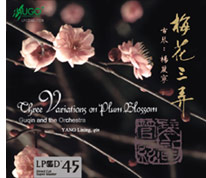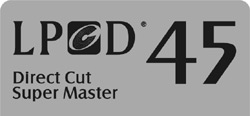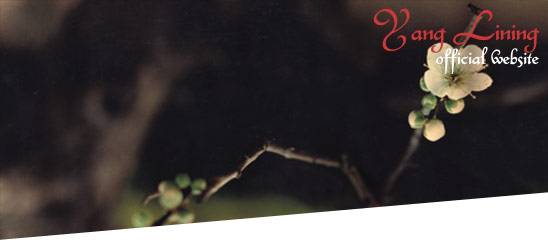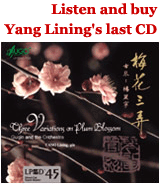LPCD: Artistic Sense + Advanced Technology
LPCD is the latest and most advanced technology researched and developed by Mr Aik Yew-Goh, the founder of Hugo Productions.
Mr Aik is a renowned recording producer and musician who spends 35 years in musical experimentations and 20 years in professional music production. LPCD is developed based on a unique set of digital processing technology which enables listeners to experience the analogue sound of the vinyl LP record from an ordinary CD player. |
 |
Mr Aik has been researching this technique for a long time. He has produced over 300 music records in the last 20 years. Every time when he compared these recordings with the master tapes, he would find that there was a difference in the audio quality, but he was unable to work out a solution due to his busy schedule in music productions. Until 2003, after producing two LPs, Mr Aik revisited this subject and did a detailed analysis on the sonic differences between CD, XRCD, SACD, etc., to pinpoint the reason why the CD and LP differ much in their tonal quality.
The general consensus among most audiophiles being that when comparing with LP, CD (including normal CD, 24K CD, XRCD, SACD and DVD-Audio) would sound tight, tensed and compressed (especially when playing at loud sound level, one would find it difficult to maintain concentration in appreciating the music and the sound system). Besides, the lack of extension at the low and high sonic frequencies has resulted in a harsher treble, inelastic bass, poor dynamics, etc. Being an LP audiophile, Mr Aik is well aware of the problem. He reckons that the only way to seek out the answer is to listen to his own recordings extensively and repeatedly, before he is entitled to voice his views.
Presently, the manufacturing of CD from the master tape requires changing the digital audio formats 5 to 6 times in the following processes: Master Tape - Master CDR - Glass Master - Metal Stamper - Pressing - CD. The last two processes are especially important as they could make or break the sound quality. It is common knowledge to audiophiles that whether it is LP or CD, the first pressing always sounds the best. A simple experiment of duplicating a CD 5 or 6 times on a home computer will prove that the last pressing will sound much inferior to the original CD.
How then to ensure that audiophiles who have been faithfully supporting the HUGO Label can enjoy the highest level of sonic fidelity? Having identified the digital distortion problem of CD, Mr Aik has focused his research of the LPCD in the following two parameters:
1. LPCD mastering
Applying HUGO's proprietary sonic spectrum processing software system on the following procedures:
(a) Using the highest specifications to convert the original analogue master tape into a digital format;
(b) Upsampling the original digital master to the highest specifications. Thereafter, adjust the tonal density, dynamic range, bandwidth, etc., using a highly precise digital processing system. Finally the digital master is encoded into a 16 bit/44.1KHz CD format. Throughout the entire digital processing, the digital system is operating in an optimal configuration with the highest purity of the AC power supply and a highly precise, military-grade digital clock. All the equipment used were protected by a proprietary anti-vibration system to ensure that all the components and the production process are free of distortion.
Although the top-notch equipment can effectively benefit the mastering production, mastering process is still very much a complex manual project which requires the mastering engineers to apply their skill and artistry meticulously at each step of the process. It is therefore not just a simple technical "transfer" from one medium to another. It is hardly surprising that the mastering of a LPCD takes a labourous 20 studio hours!

2. LPCD Production
The primary objective is to minimize the signal distortion of the digital laser reading system embedded in the CD player, and the "over-correction" by the signal correction system. In addition, a specially treated material is used to eliminate the diversion of the laser beam; thereby improving the accuracy of the laser output signal, enhancing the stability of the disc rotation, reducing the rumple and flutter rate. All of these help to reduce the pressures on the CD servo-system which otherwise can generate signal loss and distortion.
After numerous experimentations, the above process is finally adopted to produce the LPCD. What is presented to audiophiles is a disc which is many times more precise than the ordinary disc. Very fine artistry is put into the stamping / pressing processes as well as the digital format change processes to eliminate any significant noise intrusion. Special material is also used to help preserve and enhance the durability of the LPCD.
Hugo Productions not only produces its own LPCDs, it also provides the technical expertise to other companies or producers to manufacture the LPCDs on the premise that the recordings qualities are of the highest level.
LPCD products are classified into two categories, i.e. LPCD33 and LPCD45. LPCD33 is a specially manufactured CD product whereas LPCD45 is the top-of-the-line audiophile master product that is built on the best CDR master specification. Consumers need to ascertain whether their CD players could playback the CDR before they purchase the LPCD45 discs.
Now, there is no need for audiophiles to slave over their LP players. Audiophiles also need not be tortured by the noise and wow and flutter of the LP and yet still able to enjoy the highest sonic quality equivalent to an LP system. Come and enjoy the wonder of music and sound effects brought to you by LPCD.
© HUGO Productions
|


